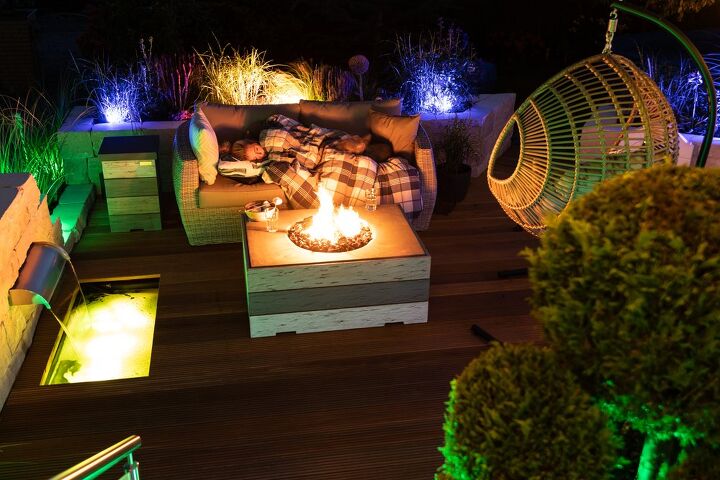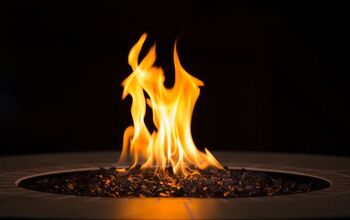Can You Use A Propane Fire Pit In A Screened Porch? (Find Out Now!)

When it comes to searching for a centerpiece for your screened-in porch, a number of questions often arise surrounding fire tables and propane fire pits. The use and safety concerns related to fire are crucial and beneficial to help consumers make informed purchases. One such question is: “Can you use a propane fire pit in a screened porch?”
Although propane fire pits and tables are designed for outdoor use only, they can be used in a screened porch if you follow specific guidelines regarding ventilation, wall clearances, ceiling and height clearances. These requirements include having at least three walls that are screened and permanently open to allow for proper ventilation.
With that said, let’s take a deeper look at the requirements needed to safely use a propane fire pit in a screened porch, as well as the minimum clearances to combustibles, and more safety guidelines.
Do You Need Deck, Porch, or Gazebo Installers?
Get free, zero-commitment quotes from pro contractors near you.

Can You Use a Propane Fire Pit in a Screened Porch?
If you want to place a propane gas fire pit on your screened-in porch, there are many factors to consider. Most gas fire pit tables, burners, and outdoor fireplaces are not UL-approved for this specific application. Although, this may depend on the manufacturer of your fire pit.
Regardless, you should have no problem using a propane fire pit in a screened porch, provided that you follow the guidelines listed below:
- At least three screened walls that are permanently open (windows that can be opened and closed do not count).
- The open area of screened walls needs to be at least 30%.
When in doubt, the best way to ensure safe placement of your propane fire pit is to consult a certified technician in your area.
Propane Fire Pit Clearance to Combustibles
When determining where to put your propane fire pit or fire table, you must make sure that you meet the minimum clearances to combustibles. This simply refers to the safe distances from combustible objects, including your home, garden shed, and the like.
Most propane fire pits can be placed on concrete patios, wood decks, under wood pergolas, directly on a lawn, in a screened-in porch, and a variety of additional outdoor spaces. Though, when placing your propane fire pit, it’s important to adhere by the following clearance to combustibles:
- Two feet from the edge of the burner
- Six feet above the burner
- Eight inches below the burner
Note: This clearance to combustibles can vary based on the specific product that you purchase, so make sure you consult the manufacturer’s instructions to choose the proper placement.
Additional Considerations
An outdoor fire pit that functions on propane allows it to be portable and does not require the use of a direct vent or chimney. So, if you want to move your propane fire pit to your screen porch, it can be done. However, in addition to the recommendations outlined above, consider the following to avoid any possibility of fire:
- Porch Size: Check the required square footage for your propane fire pit prior to installation. Each propane fire pit requires a minimum amount of space in order to be safe in a screened-in porch. These measurements will also generally include the required height of the ceiling on the porch.
- Placement: Your propane fire pit’s installation guidelines will inform you regarding the ideal and safest location. Generally speaking, the fire pit should not be placed directly next to your home or your screened enclosure. Installing your fire pit too close to either is a fire hazard. The fire pit should be place at least three feet away from all screens, walls, and windows.
- Flooring: Consider the type of flooring on your porch. Make sure that your fire pit is positioned on either a fire-retardant rug or hearth pad, especially if your porch has wood, vinyl, composite, or any other type of combustible flooring. Overall, brick, concrete, and stone are the safest flooring options.
- Ventilation: Propane fire pits need an open area for sufficient ventilation. Adhere to the specific guidelines outlined by the manufacturer regarding the minimum number of walls that can be screened-in. As previously mentioned, most require at least three screened walls, while others allow only two. Regardless, a porch that has three solid walls and one screened wall does not allow for enough ventilation.
- Upkeep: Before each lighting of your fire pit, it’s important that you perform any necessary maintenance and upkeep, including emptying the pit of all debris and soot build-up. When you light a fire pit that is dirty or full of debris, a fire can result. Do not throw foreign items into the fire pit, always shut off the propane each session, and never leave it unattended while lit. For optimum safety, always keep a fire extinguisher nearby in the unlikely event of an emergency.
Note: You should also make sure that you check with your city’s codes and regulations to ensure that you are abiding by their guidelines regarding ventilation, location, and placement. The specific propane fire pit that you purchase must also be pre-approved by your city.
Do You Need Deck, Porch, or Gazebo Installers?
Get free, zero-commitment quotes from pro contractors near you.

Related Questions
What are the safest fire pits?
Propane or natural gas fire pits that are made with durable and safe materials are the safest fire pits. Make sure to choose fire pits that have either CSA (Canadian Standards Association) or UL (Underwriters Laboratory) approval, as these two entities test fire pits to ensure that meet safety standards.
What is the ideal base for a fire pit?
If you’re constructing your own fire pit for your property, stone, brick, or concrete materials are the best option to ensure that your pit is both secure and safe. For gravel, slate, marble, or granite are the best base options as they are durable stones that will absorb heat better than alternatives.
Are gas fire pits safer than wood?
Yes, gas fire pits are typically a lot safer than their wood counterparts. Since gas fire pits do not emit smoke or sparks like traditional wood fires do, there is less of a health and fire hazard. With proper installation and maintenance, you don’t have to worry about any risk of pooling gas.

Jessica considers herself a home improvement and design enthusiast. She grew up surrounded by constant home improvement projects and owes most of what she knows to helping her dad renovate her childhood home. Being a Los Angeles resident, Jessica spends a lot of her time looking for her next DIY project and sharing her love for home design.
More by Jessica Stone



























